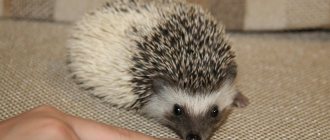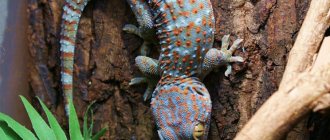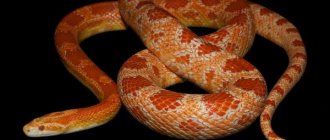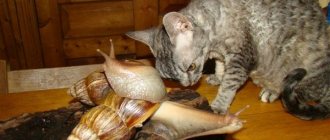Monkeys are quite cute animals, but when they are the size of your palm, the degree of cuteness increases several times. It's hard to imagine a person who hasn't seen a monkey. Although they do not live in our usual habitat, but prefer tropical forests, they have become frequent residents of circuses, zoos and other shows involving various animals. They are easy to tame and teach certain actions.
The smallest monkeys in the world have an easy-going and friendly character; over time, this animal can become a good friend for its owner. In addition, they are very smart and quick-witted.
Our article presents ten tiny primates and describes the characteristics of these animals with photographs. The length of some barely exceeded 10 centimeters.
Golden lion marmoset
- Body length: 20-25 centimeters.
- Weight: about 900 grams.
This is the largest monkey of the marmoset family. Its tail can grow up to 37 centimeters. The golden lion tamarin gets its name from its resemblance to a lion. Around the monkey's head there is fur like a mane, which glows golden in the sun. All wool shimmers beautifully in the sun's rays and is therefore compared to gold dust.
Marmosets take care of their appearance and always take care of their fur. They live mainly in groups of 3 to 8 members.
How to choose and cost of an animal
The choice of the type of monkey to keep depends, first of all, on the thickness of the wallet. This animal is expensive, and its maintenance is also quite expensive.
Weigh this argument well: if there is little money, then there is nothing to choose. The answer to the question of how much a domestic monkey costs is from $1,000. Marmosets sell for $1,500 to $1,800. Some types of monkeys cost up to $8,000.
Pay attention to the size of the living space: it is better if the monkey has a separate room. Monkeys can carry dangerous diseases, so make sure you have a certificate from a veterinarian.
Do not be tempted by low prices and attractive offers, refuse to buy primates from dubious dealers (read the reviews).
The animal must have a healthy and well-groomed appearance and not be aggressive.
It is good to buy baby monkeys, then it will be easier to tame them. When buying an adult animal, you need to take into account that it is accustomed to the conditions of its previous owner and considers him the leader.
Please note that these are very sociable animals. If you have a reserved character or work “from morning to night”, refuse to breed them at home.
Some species of monkeys live up to 40 years, so consider whether your age will allow you to properly care for the animal over these years.
In addition to monkeys, you can also have a cat, dog, fish, hamster, guinea pig or parrot in your home.
Black lion marmoset
- Body length: 25-24 centimeters.
- Weight: about 500-600 grams.
These monkeys are completely black except for their red buttocks. There is a thick mane around the head. Their muzzle is flat and hairless. The tail can reach 40 centimeters in length.
Black lion marmosets live for about 18 years. However, recently their numbers have decreased significantly. They have been given the status of “endangered”. The habitat of these monkeys is gradually being destroyed, and poachers are hunting for individuals.
Capuchins
Capuchins are perhaps the most common and famous monkeys kept in captivity. These species of domestic monkeys have miniature sizes from 30 to 50 cm in length, their natural habitat is the south of South America. Capuchins have a fairly long lifespan for monkeys - about 25 years.
Breeds of domestic capuchin monkeys have a cheerful and unpredictable disposition. These are funny, stubborn animals that love to play pranks, make faces, and mimic their owners and their guests. The facial expressions of capuchins are very rich - they are active, emotional animals that never sit still. To be kept in captivity, they need to reproduce natural conditions: a cage where they could jump on branches and hang on their tails.
Capuchins love children's toys - they really look like little fidgets who don't want to grow up. During games, they make a huge amount of sounds, muttering and chirping, so you need to be prepared for the fact that these animals are quite noisy. Another feature of these monkeys is that they love rags, busily wipe their faces with them, and cover themselves while sleeping.
Red-handed tamarin
- Body length: 30 centimeters.
- Weight: about 500 grams.
The animals are most common in South America and Brazil. Their tail is larger than their body and can grow up to 45 centimeters. The color is black except for the arms and legs, which are yellowish or orange-red.
The red-handed tamarin in food . They can eat insects and spiders, as well as lizards and birds. They also do not refuse plant foods and actively consume various fruits.
Tamarins are active during the daytime. They live in a family circle of 3-6 individuals. Within the group they are friendly and look after each other. They have only one dominant female who bears offspring. By the way, only males take care of newborns. They carry them everywhere with them and only bring them to the female for feeding.
Wistity
These are one of the smallest monkeys that are usually kept in the house. Their body length is only about 20 cm, they are distinguished by a bright, beautiful color - the whole body is covered with thick hair and stripes, and the ears are decorated with white or black tassels.
These are very touching animals: they have a cheerful, emotional disposition, they love to play and have fun, frolic, and jump a lot and actively on the branches. However, if danger arises, they become very frightened and literally panic: they have a very delicate psyche.
Whisties love fruits and vegetables and can be fed with infant formula. Among all the others, these pet monkeys adapt most comfortably to captivity conditions.
Silver marmoset
- Body length: 22 centimeters.
- Weight: about 350 grams.
The fur color of the silver marmoset ranges from silver to brown. The tail is black and grows up to 29 centimeters. They live in large family groups of about 12 individuals. Within a group there is a dominant and a subordinate.
Only the dominant female produces offspring; the rest do not participate in reproduction. The female gives birth to no more than two cubs. After six months, they already switch to adult food, and at the age of 2 years they are considered independent and adult individuals. For the entire six months, when the cub feeds only on mother’s milk, the male takes care of it and carries it on his back.
Keeping a monkey at home
No matter what type of monkey you are, you will need to keep it in an enclosure or cage. For this purpose, it is advisable to allocate a part of the room to the pet. When letting a monkey out for a walk around the apartment, you need to closely monitor it, since the mischief-maker is capable of damaging things, tearing books, etc. If there is an aquarium with fish in the house, it is possible that this minx will try to feast on the living creatures.
A curious monkey can turn off a water tap or turn on a household appliance. Therefore, for the safety of you and the animal, mandatory supervision is simply necessary if you decide to let the primate out for a walk around the house.
You can place a monkey’s cage in one part of the room, and use the neighboring one (which is larger) as a walking area. Don’t forget to take out everything that is breakable, torn, or valuable. Of course, the best solution would be to give the monkey the whole room, because this primate can be quite noisy.
When choosing a room for a monkey, it is worth knowing how many degrees of heat it should be. The optimal temperature is +22 °C. The room should be sufficiently light and dry. When choosing a cage for a small pet, do not forget that the creature is very active. The monkey needs to move and jump, so you should buy a cage that is durable and spacious. A retractable metal tray will make caring for your macaque easier. You need to pour river sand and large shavings onto the bottom. By the way, there is no need to line the bottom with newspapers and paper, since the monkey will tear them into small pieces.
Crested marmoset
- Body length: 20 centimeters.
- Weight: about 450 grams.
They received this name due to their unusual crest. The crested marmoset from its forehead to the back of its head . This hairstyle makes it very easy to recognize the monkey's mood. For example, if she is angry, her crest rises.
When severely irritated, monkeys bar their teeth ferociously. They have a very unusual appearance, which is immediately remembered and it is impossible to confuse them with another species. Monkeys prefer to live in the forests of Colombia and Panama.
Pygmy marmosets are the smallest monkeys in the world
There is a palm-sized monkey - a pygmy marmoset. In size it can be compared to a small kitten. The animal is very agile. Marmosets move through the jungle, jumping from branch to branch. The primate's body, excluding the tail, is from ten to fifteen centimeters. The tail itself often exceeds the length of the entire body. An individual can weigh from one hundred to one hundred and fifty grams. The animal has thick, long fur, brown on top, white or yellow below. They live in western Brazil, the upper Amazon, Ecuador and northern Peru.
Pygmy marmosets fit into the palm of your hand
Marmosets usually live in the jungle, spending almost their entire lives in trees; at night they are in hollows. The animal's legs are so well developed that they can jump up to two meters. Thanks to their sharp claws, marmosets can move along vertical branches.
Pygmy marmosets can jump 2 meters
Monkeys obtain food using sharp incisor teeth. Their main delicacy is tree sap. To get it, monkeys gnaw through tree bark. They also indulge in fruits and eat spiders, insects and small birds. They are content with fresh water, which they find in flowers and on the leaves and shoots of plants. Due to their miniature size and low weight, these animals are able to obtain food from thin branches where larger and heavier jungle inhabitants cannot reach.
The smallest monkeys eat spiders
Pygmy monkeys live in groups with a male, female and offspring. Often there are four generations in a group at once. Usually the female gives birth to two cubs, each weighing about fifteen grams. It seems that the marmosets are chirping something to each other non-stop. These are sociable animals. From time to time they whistle, and if they want to report danger, they start screaming loudly. It is impossible to calculate the total number of these dwarf primates in nature, which is due to both their mobility and camouflage coloring. It is definitely true that they are not on the verge of extinction. It is known that their average life expectancy is ten years.
Baby pygmy marmoset
We can say that the marmoset is like a cat, a bird and a person at the same time. These monkeys are also kept in captivity. It is important to provide them with a constant temperature within twenty-five to twenty-nine degrees with a humidity of more than sixty percent. They are placed in an enclosure with decorative elements and shelters.
By the way, monkeys are considered dangerous. They are even included in the list of the most dangerous animals in the world. There is a detailed article about this on the website uznayvse.ru.
Geoffroy's Marmoset
- Body length: 20 centimeters.
- Weight: about 190-250 grams.
They have incisors with which they gnaw through the bark of trees in search of tree sap. During the rainy season, they spend most of their time resting and getting food, but during the drought they are very active.
When it comes to food, Geoffroy's marmosets are unpretentious. Their diet includes insects, fruits, plants and tree sap. They live in large groups (8-10 individuals) with one dominant pair. The cubs are cared for by all members of the group until they are 18 months old. Then they become independent.
How to properly care for a monkey
So, a monkey has appeared in your house. There can be many reasons for making such an extraordinary purchase. But the very fact of taming an exotic pet imposes on you a bunch of responsibilities that you must observe when raising your “ward.” In this article you will learn all the intricacies of caring for a pet monkey. Be prepared right away for the fact that care will be comparable to guarding a small child. Let's start with the conditions of detention. The monkey is a very heat-loving animal, so it needs to be protected from drafts, high humidity and cold. The animal will live in a cage, and do not skimp on its dimensions. Crowding will not lead to anything good, and will disrupt not only the physical, but also the psychological shape of the animal. It is recommended to place the enclosure away from windows and balconies. You can place it close to the battery (but not close to it). Inside there must be various perches for climbing, feeders, drinking bowls, and toys. Provide your pet with your own crib! As for food, it is strictly forbidden to let the animal near your own table. At first the idea may seem very interesting and funny, but remember that almost all monkeys are prone to gluttony. It will not lead to anything good, since obesity causes a number of other serious diseases, such as diabetes, high blood pressure and limb deformities. Everything is like people! The monkey must have a food ration, and we serve food three times a day, wash it thoroughly, clean it, cut it and remove the bones! Do you often go to the dacha in the summer? Great, because the monkey can also go with you, especially if the weather is sunny and hot outside. When you release your pet into the wild, make sure that it does not run far from its home, because such an animal alone can die, and the loss will be quite difficult for you. You can play with the primate on your own so that he can unwind, and you will get a lot of positive emotions. Just in case, there should be a net next to the cage so that you can always catch an escaped bully. Let's move on to the issue that concerns the cleanliness of the cell. Cleaning needs to be done almost every day because monkeys cannot live in dirt. The entire containment field must be covered with spruce sawdust so that the filler absorbs strong odors. Monkey excretions emit a very strong odor, from which it is better to rid yourself, your family and your pet. If you can't find sawdust, cover the entire floor with peat chips as they make an excellent alternative. Cleaning the inside of the cage should be done several times a day (ideally). We clean using cleaning products, dustpans and brooms. During the cleaning period, it is best to release the monkey, but not further than the room in which the enclosure is located. Remove vases, flower pots from it in advance, in general, anything that may lie unevenly. Since domestic monkeys have a very mischievous character, everything can fly to the floor or be hidden in a cage. You may not have enough jewelry after walking your pet. These are the main points that you should follow when buying an exotic pet for your home. Professional breeders strongly recommend taking monkeys in pairs, because it will be much easier for them. It is advisable to take a boy and a girl. They will be able to continue their lineage (the basis of the breeding and sales business), and also satisfy all their natural needs during puberty, which is very important! Take the issue of raising animals as seriously as possible, and love your pets.
Source: www.minepets.ru
Marmoset Göldi
- Body length: 20-23 centimeters.
- Weight: about 350 grams.
This species is protected and movement through customs is strictly limited. The tail of Göldi's marmoset is larger than its body and grows up to 15 centimeters. They live for about 18 years, but with proper care at home or in special institutions for animals, life expectancy increases by 5-6 years.
Her appearance is very unusual, but despite her small size, her muzzle expression is very concentrated and even a little angry. In the wild, they are shy and do not let anyone get close, but if a person manages to tame them, they will become excellent friends.
Feeding
Under no circumstances should you feed the monkey from the table. The main diet should be special food for monkeys, which contains the necessary elements and minerals. Domesticated animals should be given fresh fruits and vegetables, cereals, seeds, and sometimes boiled eggs should be included in the diet. Once a week, a pet monkey should receive boiled fish or meat. Insects will be a real delicacy for the monkey.
All products must be fresh, thoroughly washed and free of preservatives. If an animal's diet is not balanced, it lacks vitamins, this will immediately affect its health.
Common marmoset
- Body length: 16-17 centimeters.
- Weight: about 150-190 grams.
The size of this monkey is more like a squirrel. Adults have a distinctive feature - large white tufts on their ears made of long hair.
These monkeys are very emotional and quickly fall into unreasonable panic. Their emotions are expressed through gestures and facial expressions. It is very easy to understand what exactly an ordinary marmoset at the moment.
They live in family groups of up to 15 members. They resolve all territorial conflicts with neighbors using sounds; as a rule, they do not like to fight. The average life expectancy in nature is about 12 years. At 2 years old, the individual is already considered an adult.
Cynomolgus macaque
The second name for these monkeys is the crab-eating macaque (lat. Macaca fascicularis), but crabs are not its main food. The animal's fur is brown at the top and gray towards the bottom. According to the variety of color, there are 2 types of Javan macaques. The first has yellow-brown fur, the second has darker hair and the face of these monkeys is black. An adult animal reaches an average height of 60 cm. The weight of an adult male is 4.5-8.5 kg, females 2.7-3.8 kg.
Cynomolgus macaques are quite unpretentious, so this breed is often kept at home. In the southern regions, an enclosure and an insulated shed are enough for monkeys to live. Another argument in favor of this species is that they quickly become tame, however, there are cases when a friendly animal suddenly changes its behavior - it becomes aggressive and can bite a person.
Tiny marmoset
- Body length: 18 centimeters.
- Weight: about 150-180 grams.
The coat color is mainly olive-brown, with golden-yellow or gray-yellow on the belly. Most often found in the Amazon rainforest and Brazil.
In total there are about 10 thousand individuals. The tail is up to 23 centimeters long, completely black. The ears and face are mostly hairless, but there is a large tuft of hair on the head by which this species of monkey can be easily distinguished. The tiny marmoset is not as common as the pygmy marmoset, but they are still often kept as pets.
What breeds of monkeys are suitable for home
It is highly not recommended to purchase medium and large monkeys for your home (fortunately, this is practically impossible to do legally), which are distinguished by a very complex and unpredictable character and serious physical strength. It is better to opt for small specimens, among which the following are popular:
- macaques;
- capuchins;
- spider monkey;
- marmosets;
- saimiri.
The Javanese macaque (crabeater) has a size of up to 60 cm and is distinguished by a touching black muzzle. Indian, Bonnet, is slightly larger (70 cm) with thick gray wool. The Japanese Shorthair can grow up to 1 m. Rhesus monkeys have a strong build and are often aggressive when they reach sexual maturity.
The capuchin (broad-nosed monkey) attracts with its peculiar black and white color and reaches 60 cm. The spider monkey (up to 80 cm) has black skin and brown fur.
The group of small monkeys - marmosets - has dozens of species. One of the smallest, tamarins, weigh only about a kilogram and can have different colors. Even smaller are golden, silver and other marmosets, which reach 30 cm and weigh about 300 grams. Comparable in size are the saimiri, nicknamed the “death’s head” for the black skin around the nose and mouth and the white outline around the eyes.
From the point of view of an easy-going disposition, marmosets and cynomolgus macaques are preferable.
Social structure
These animals are diurnal.
As a rule, they form family flocks. Up to 9 individuals live in one group. The group always has one dominant male, a female in childbearing age, and several generations of young. One such group needs an area of approximately half a hectare . As the trees become depleted, the group moves. If another group appears on the territory, the male defends the border.
There is constant communication between members of the same group using audio and visual signals. The sounds that monkeys can make are very diverse: from whistling to grinding. Different sounds carry specific information:
- a trill with an open mouth can indicate alarm or challenge;
- trill with a closed mouth a call for contact and interaction,
- chirping denotes submission.
In addition, marmosets can produce a supersonic cry that the human ear cannot detect.











